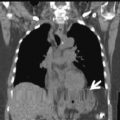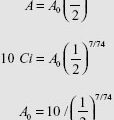12
RADIATION SAFETY AND REGULATIONS
12.1 RULES AND REGULATIONS
What is the frequency for inventory and survey for a radioactive material storage area, for example, Cs-137?
Question 2
What is the survey limit requirement for a patient’s release who has received a radioactive source or radiopharmaceutical?
Question 3
What is the frequency for survey meter calibration?
Question 4
What does ALARA stand for?
Answer 2
The Nuclear Regulatory Commission (NRC) guidelines are based on keeping the radiation level to a member of the public the patient may interact with below 500 mrem. Therefore, the survey limit is different depending on the source used, a table is provided by the NRC. For I-131 it is <7 mrem/hr and for I-125 it is 1 mrem/hr, both measured at 1 m from the patient surface.
Answer 3
Annually, before the initial use and after any repair.
Answer 4
As Low As Reasonably Achievable. This is the basis of radiation protection planning and accounts for the cost and effort to reduce the risk of radiation to zero.
Question 6
As a radiation worker, if you separately undergo radiation therapy, does this affect your annual dose limit?
Question 7
What is the lifetime limit for a radiation worker?
Question 8
What is equivalent dose?
The National Council on Radiation Protection and Measurements (NCRP) definition of NIRL is “the level of average annual excess risk of fatal health effects attributable to radiation below which efforts to reduce radiation exposure to the individual is unwarranted.” The current value is 0.01 mSv.
Answer 6
The 50 mSv per year is an occupational dose limit; it does not include radiation from background, medical exposure as a patient, or dose as a member of the general public.
Answer 7
The National Council on Radiation Protection and Measurements (NCRP) limit is 10 mSv multiplied by age in years.
Answer 8
Equivalent dose takes into account the different biological effects of different types of radiation, such as photon, proton, thermal neutrons (<10 MeV), neutrons, and heavy particles. Equivalent dose is the dose in Gy (J/kg) multiplied by the radiation weighting factor (WR) of the radiation. Its unit is the Sievert (Sv). The old unit was rem, 100 rem = 1 Sv.
What are the International Commission on Radiological Protection (ICRP) recommended values for radiation weighting factors WR?
Question 10
What is effective dose equivalent (EDE)?
Question 11
What are the National Council on Radiation Protection and Measurements (NCRP) values for tissue weighting factors wT?
What is the whole body effective dose equivalent (EDE) limit for a member of the general public?
| Types of Radiation | Radiation Weighting Factor |
|---|---|
| X-ray, Gamma ray, electrons, and beta particles | 1 |
| Protons | 2 |
| Neutrons | A range from 5 to 20 depending on energy |
Answer 10
Just as equivalent dose takes into account the damage of different types of radiation, effective dose takes into account the sensitivity of different tissues, effective dose equals absorbed dose multiplied by the tissue weighting factors. EDE is then the combination of absorbed dose, multiplied by the radiation and tissue weighting factors.
Answer 11
| Tissue | Tissue Weighting Factor |
|---|---|
| Gonads | 0.2 |
| Bone marrow, colon, lung, stomach | 0.12 |
| Bladder, breast, esophagus, liver, thyroid | 0.05 |
| Bone surface, skin | 0.01 |
| Remaining tissues (adrenals, brain, small and large intestine, kidney, muscle, pancreas, spleen, thymus, and uterus) | 0.05 |
The sum of the tissue weighting factors is 1, so the effective dose equals the absorbed dose when the body is uniformly irradiated.
NCRP Report 116 Limitation of Exposure to Ionizing Radiation, 1993
Answer 12
1 mSv/y (100 mrem/y), this is determined based on risk compared to other every day hazards.
Question 13
What is the whole body effective dose equivalent (EDE) limit for an occupational worker?
Question 14
What is the effective dose equivalent (EDE) limit for a pregnant occupational worker?
Question 15
What is the dose limit for radiation workers to the eyes and extremities?
Question 16
What types of radiation badges are available?
Answer 14
5 mSv/term (0.5 mSv/month).
Answer 15
The extremities are limited to 500 mSv/y and the lenses of the eye to 150 mSv/y.
Answer 16
X-ray film, thermoluminescent dosimeter (TLD) badges, and optically stimulated luminescent dosimeter (OSLD). These are available as body and ring badges.
What is the average yearly exposure (per person) in the United States from background radiation?
Question 18
What percentage of medical radiation exposure do CT studies account for?
Stay updated, free articles. Join our Telegram channel

Full access? Get Clinical Tree






